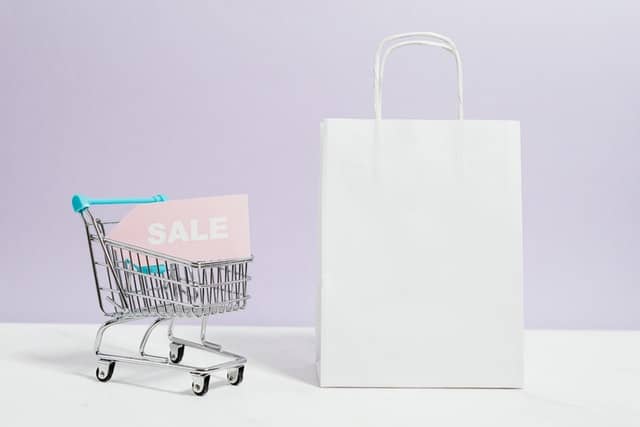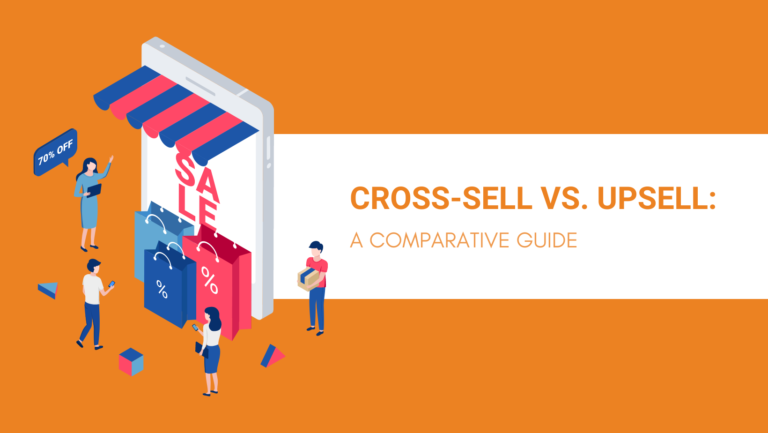Marketers often forget that running a successful business isn’t just about generating new leads.
Aside from increasing your average order values, you also have to retain your old customers to maximize the profit.
The most common marketing strategies you can use to achieve this are cross-selling and upselling.
People often get confused between the two marketing tactics but they offer their own distinct benefits.
Let’s explore the difference between cross-sell vs. upsell and how you can implement these strategies in your business.

What Is Cross-Sell?
Cross-selling identifies products that can be sold to complement the original item you’ve added to your cart.
Most businesses implement the cross-sell strategy by offering discounts if two or more items are purchased together.
The idea behind cross-sell is to basically tempt the customer to make an impulse purchase during the checkout process.
The complementary item usually leans towards the cheaper side so the customer doesn’t think much before adding it to the cart.
For example, when a customer is buying a phone, they would see deals to purchase a phone case and a pair of headphones along with it.
Restaurants also follow the cross-selling model by recommending soups, drinks, fries, and salad along with the main course.
What Is Upsell?
Upselling encourages customers to upgrade, include add-ons, or buy a more expensive product to increase the overall value of the order.
Upselling also targets customers after they add a product to the cart or initiate checkout.
It’s more like a final sales effort in which you tempt them by showing an upgraded version of the product they’re about to purchase.
The reason upselling works is because customers have likely already researched the product and are also aware of its add-ons and different models.
Showing them the better option at the last moment, especially with a flashy discount may change their mind and help you generate more profit.
The upsell strategy can easily be applied to smartphones as well.
Right before the customer is about to check out, you can recommend another variant with higher storage, faster processing speed and so on.
Difference between Cross-Sell and Upsell
The key difference between cross-selling and upselling is that cross-sell invites the customer to buy a product that complements or relates to their original purchase.
Upsell, on the other hand, encourages customers to switch toward a higher-end version of the product they’re about to purchase.

Both of these marketing tactics are implemented after the customer adds the product to the cart or initiates checkout.
Ultimately, the main goal of both strategies is to help you generate more profit, but they use a slightly different approach.
Upselling does it by increasing your profit margin after making the customer upgrade towards a higher-priced product. While cross-selling tempts the customers to add more products to the cart and increase the average order value.
Why Are Cross-Sell and Upsell Important for eCommerce?
Unless you’re going for dropshipping, most eCommerce businesses require a ton of investment to start. Marketing your store alone can cost hundreds if not thousands of dollars.
So now that customers are finally visiting your store, you need to implement any strategy you can to increase your profit and get more return on investment (ROI).
But of course, that doesn’t mean you recommend random items to your customers in an attempt to squeeze every penny from their pockets.
The ethical way to implement upselling and cross-selling strategies in your eCommerce store is by making valuable recommendations to the customers.
Your primary goal shouldn’t be to tempt the customers to make an impulse purchase but to show them products that meet their current needs and also inform them about better options.
After all, customers don’t know what they want until they see it, and that’s exactly what cross-selling and upselling strategies are based on.
Properly implementing these marketing tactics will not only increase your average order value but also your customer retention.

Examples of Cross-Sell and Upsell
Cross-selling and upselling are useful marketing tactics practiced in almost every industry. So here are the most successful examples of businesses that have applied these strategies:
1. Amazon
Amazon hasn’t climbed to the top in the world of eCommerce based on luck alone. The company has executed all sorts of marketing strategies to attract and retain customers with cross-selling and upselling not being an exception to it.
If you’ve ever purchased a product from Amazon, you would notice that right before or after the checkout process, you would see suggestions for “similar products you might be interested in”.
Some of those would be related to your purchase, while others would be an upgrade. And rather than popping a huge notification for those products on your face, they would recommend them in the most non-invasive way.
This is a great example of how you can implement cross-selling and upselling to your eCommerce store without ruining the customer experience.
2. Apple Store
Apple Store is one of the best examples of how you can successfully implement the upselling strategy for your business.
Even if Apple doesn’t market their new products, people don’t mind paying a pretty penny for their higher-end products.
This just goes to show how loyal their customer base is and the trust they have for the brand along with the quality they’re bringing.
That’s why, if you’re giving an upsell recommendation to your customers, then make sure that it’s not just for the sake of money.
But rather, you’re actually providing them with superior quality and value for the additional money they’re paying.

3. McDonald’s
Mcdonald’s is one of the pioneers of implementing cross-selling and upselling strategies in the fast-food industry.
At this point, almost everyone has eaten Mcdonald’s, and you probably noticed their customer representatives asking “Would you like a drink and some fries with your order?”
Similarly, they would also ask if you would like to pay an additional amount for an upsized meal. These are cross-selling and upselling strategies at their finest.
How to Identify Upsell and Cross-Sell Opportunities?
Trying to figure out how you can implement upsell and cross-sell opportunities for your business? Here are some tips you can follow:
1. Create a Map of Products
In order to make sure that your customers aren’t spammed by uninteresting offers, you first have to make a map of your products.
Depending on the item you’re selling, list similar products to complement it for identifying cross-selling opportunities. After that, create multiple bundles or product kits and conduct split testing to see which one is performing the best.
Identifying upselling opportunities is a bit trickier because you first have to make sure that your products offer upsell potential, to begin with.
We recommend starting with competitor research to see what upgrades other sellers in the market are offering.

2. Keep a Track of Your Sales
Collect and study the behavioral data of your customers to gain more insight into the kind of products people normally purchase together.
Keep a track of the items they are adding to their carts, the pages they’re visiting, and then provide the options according to their interests.
3. Think From a Customers Perspective
Ask yourself what improvements you can bring to your current products. For example, if you’re buying a wall clock then you would obviously need a pair of batteries with it.
Just think from a customer’s perspective and how you can bring improvements or suggest related items to improve their buying experience.
Cross-Sell and Upsell Best Practices
If you’re planning to use the cross-selling and upselling strategies for your business then here are some best practices to follow:
1. Know Your Audience
Upselling and cross-selling aren’t just about making more money, it’s also about customer retention. And this can only be done if you make an active effort to know your audience.
After your customer has purchased from your store, take a close look at your customer feedback and data.
Learn more about their shopping needs and only then recommend products that are relevant and useful for them.
2. Don’t Push the Products
We all want to generate more profit, but that doesn’t mean you should sacrifice the customer experience in the process.
Don’t push the cross-selling and upselling products to the customers’ face with huge popups.
Try giving your recommendations in a more non-invasive manner so you don’t ruin the customer journey. Take notes from platforms like Amazon on how you can do that.
3. Understand Customer Requirements
This should be obvious enough, but always avoid upselling products that don’t directly meet the requirements of your customers.
Try interacting with them to understand their needs and only then, give useful and honest suggestions.
There’s no point in getting a sale if your customer is left dissatisfied because it would ultimately damage the reputation of your store.
FAQs about Cross-Sell and Upsell
What Are the Benefits of Cross-Selling and Upselling?
If done right, then here are some benefits that cross-selling and upselling can offer:
- Customer Retention – Customers are likely to return to your store if you’re offering relevant and useful suggestions to them.
- Increase Profit – Customer retention can get you recurring orders, which in turn, can help you generate a significant amount of profit.
- Building Trust – Understanding the needs of your customers and providing them useful suggestions can help you build brand loyalty because it shows that you’re making an effort to learn about their interests.

Are Upselling and Cross-Selling Same as Suggestive Selling?
Suggestive selling is a practice that refers to introducing your customers to other products in your store. So technically, both upselling and cross-selling are types of suggestive selling.
Summary
Cross-selling and upselling are powerful marketing strategies but they aren’t as straightforward as they look.
Implementing them into your business requires empathy, awareness, and also a bit of trial and error.
Just keep in mind that your main motivation should not only be to make a profit, but to also improve the customer experience.
So if you’re ready to launch or grow your business, then NicheDropshipping can help you source your desired products to cross-sell and upsell.
Just drop us a message, and we’d be more than happy to give you a free quote at any time.

